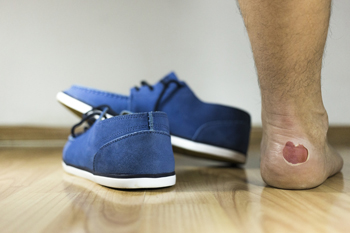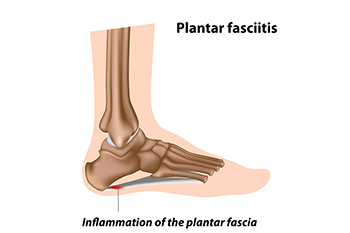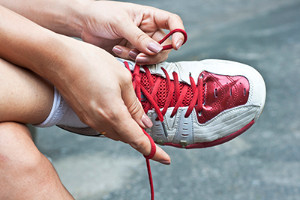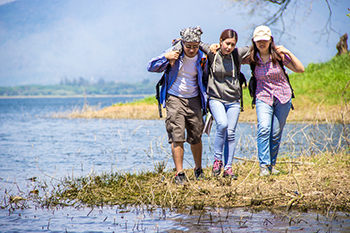Items filtered by date: December 2023
Impact of Foot Blisters on Daily Activity

Friction blisters, often just a minor annoyance, can seriously hinder athletes, soldiers, and others who spend a lot of time on their feet. These blisters form from repeated rubbing and are filled with fluid. They are particularly common in athletics and the military due to activities like marching, running, and jumping. While some people are more likely to get blisters, there are ways to reduce the risk. To prevent blisters, it is recommended to gradually increase the intensity of activities and use the same gear. Choosing synthetic, moisture-wicking socks are better than cotton for keeping feet dry. Shoe fit is also important, as shoes should fit well and have adequate room for toes. Custom-made insoles can help with blisters, and skin coverings and tapes that absorb friction can also be helpful. If foot blisters are impacting your daily activities, it is suggested that you make an appointment with a chiropodist for more advanced treatment.
Blisters can usually be treated at home, however, if you have recurring blisters or experience significant discomfort or pain, please consult with one of the chiropodists from Complete Family Footcare & Therapy. Our clinicians will assess your condition and provide you with quality foot and ankle treatment.
What Is a Blister?
A blister is a small pocket of fluid in the upper skin layers and is one of the body’s natural responses to injury or pressure. Blisters can also result from burns, fungal or viral skin infections, and the feet are particularly prone due to ill-fitting footwear and friction. Friction on the skin causes the upper layer of skin to separate from the lower layers. The space that this separation creates then becomes filled with a liquid called serum, which protects the lower layers of skin.
Treatment
If you notice a blister on your foot, you can cover it with a soft bandage or dressing to protect it. Popping the blister is discouraged. Doing so exposes the raw skin underneath it to bacteria and also raises the risk of infection. If a blister pops naturally, let it drain before covering it with a bandage. Blisters usually heal on their own or with home treatment, however, if your blister is recurring, very painful, or appears infected, it is recommended that you see a chiropodist for treatment.
Prevention
You can help to prevent blisters by wearing comfortable, well-fitted shoes. Keep your feet dry by wearing moisture-wicking socks and dust your feet with talcum powder if they tend to get sweaty. If you have areas on your feet that are more susceptible to blisters, you might be able to prevent the blister from forming by covering it with a pad.
If you have any questions, please feel free to contact our offices located in . We offer the newest diagnostic and treatment technologies for all your foot care needs.
Causes and Risks of Plantar Fasciitis

Unveiling the causes and risks of plantar fasciitis reveals an intricate network of tissues and ligaments that play a vital role in stabilizing your feet during movement. The main cause of plantar fasciitis lies in the excessive strain placed on the plantar fascia ligament on the sole of the foot, particularly at the point where it attaches to the heel. Engaging in high-impact sports or returning to activities too quickly after a break increases the risk of small tears around this attachment point, leading to inflammation. Occupations that require standing for extended periods of time can also contribute to the development of plantar fasciitis. Conditions like pronated feet, flat feet, or high arches create an uneven distribution of weight, putting added stress on the plantar fascia. Additionally, short calf muscles or a tight Achilles tendon constantly tug on the plantar fascia, increasing tension and vulnerability. Being overweight also places additional strain on the plantar fascia, heightening the likelihood of developing the condition. Additionally, age also contributes to the risk, as tissues become less elastic, and the fat pads under the heel tend to thin over time. For effective management of plantar fasciitis, it is suggested that you schedule an appointment with a chiropodist.
Plantar fasciitis can be painful and interfere with your daily activities. If you are experiencing foot or heel pain and believe you may be afflicted with plantar fasciitis, please consult with one of the chiropodists from Complete Family Footcare & Therapy. Our clinicians will assess your condition and provide you with quality foot and ankle treatment.
What Is Plantar Fasciitis?
Plantar fasciitis refers to the inflammation of the plantar fascia, a ligament that runs along the bottom of the foot and connects the heel bone to the toes. Repetitive activities, such as running or jumping, can injure the plantar fascia over time. Plantar fasciitis can also be caused by flat feet, high arches, pregnancy, and activities that put excessive pressure on your feet, like standing all day for work. When the plantar fascia becomes inflamed, it causes pain and discomfort.
Symptoms
Typical symptoms of plantar fasciitis include:
Stabbing pain near the heel
Pain that is worst in the morning or after a period of rest
Pain that increases after exercising
Swelling
Tightness in the Achilles tendon
Diagnosis
Plantar fasciitis is typically diagnosed via medical history and physical examination.
Treatment
Treatments for plantar fasciitis include resting and icing the affected foot, stretching the foot, taking medications to reduce inflammation, and wearing orthotics. In severe cases where pain does not improve with conservative treatments, injections or surgery may be recommended.
If you have any questions, please feel free to contact our offices located in . We offer the newest diagnostic and treatment technologies for all your foot care needs.
A Comprehensive Overview of Running Shoes

The world of running shoes offers a diverse array of options, each tailored to cater to specific needs and preferences of runners. Neutral running shoes, the most common type, provide balanced cushioning and support suitable for runners with a neutral gait. Stability shoes, characterized by additional arch support, benefit individuals with mild overpronation. For those with severe overpronation, motion control shoes offer reinforced stability to counteract excessive foot rolling. Minimalist shoes, at the other end of the spectrum, aim to provide a barefoot-like experience with lightweight design and reduced cushioning. Trail running shoes, designed for off-road adventures, feature rugged soles for enhanced traction and durability. Racing flats, built for speed, prioritize lightness and flexibility. Understanding the nuances of these various types of running shoes empowers runners to make informed choices aligned with their unique running style and terrain preferences, ensuring a comfortable and injury-free running experience. If you would like additional information about what type of running shoes to purchase for your individual running needs, it is suggested that you consult a chiropodist.
The right running shoes can sometimes be difficult to find. With so many options on the market, it’s important to know the unique needs of your feet prior to buying running shoes. If you require assistance, please consult with one of the chiropodists from Complete Family Footcare & Therapy. Our clinicians can help you maintain the health of your lower limbs and your mobility.
When looking for running shoes, take into consideration:
The type of running you will be doing
The terrain you plan to run on
Your gait or running pattern
Your arch type
Other unique foot needs
A chiropodist can help by examining your feet and your gait to determine what types of shoes may be best for you. Some runners may require motion control shoes, which prevent your foot from rolling too far inward while you run. Others may need stability shoes, which offer more balance, cushioning, and support. When shopping for shoes, make sure that they are the right size, fit comfortably, and are made of breathable materials.
If you have any questions, please feel free to contact our offices located in . We offer the newest diagnostic and treatment technologies for all your foot care needs.
When Hikers Should Consult a Chiropodist

Hiking offers a great way to explore nature and stay active, but it can be demanding on their feet. If you experience foot issues as a hiker, consider seeing a chiropodist. Blisters are a common complaint among hikers, typically healing within a couple of weeks. However, if you notice that your blisters are not healing, it is important to consult a chiropodist. The lingering blisters may be infected or aggravated by your footwear, and this type of doctor can determine the cause and suggest effective treatments and lifestyle adjustments. Additionally, if you experience ongoing arch pain, especially after taking rest days, this could be a sign of conditions like plantar fasciitis or heel spurs. These issues can last for a long time without proper treatment, which can include wearing specialized orthotics or receiving cortisone injections. Lastly, if you feel a sharp, localized pain on the top of your foot that worsens when pressed, it could indicate a stress fracture. This type of injury is often seen in long distance hikers and requires a chiropodist's examination, possibly followed by wearing a protective boot for healing. If you are a hiker, it is suggested that you make an appointment with a chiropodist if you suffer from any type of foot or ankle pain related hiking.
Injuries to the foot and ankle are very common among athletes. If you have experienced an injury, please consult with one of the chiropodists from Complete Family Footcare & Therapy. Our clinicians will assess your condition and provide you with quality foot and ankle treatment.
Common Injuries Among Athletes:
Achilles tendon injuries
Ankle strains or sprains
Plantar fasciitis
Fractures
Turf toe
Joint dislocations
Sever’s disease
Morton’s neuroma
Symptoms
Symptoms will depend on the cause and severity of the injury. Common symptoms for a foot or ankle injury include pain, swelling, tenderness, bruising, a reduced range of motion, and difficulty bearing weight or walking on the affected foot or ankle.
Diagnosis
Sports injuries are typically diagnosed after carefully examining the affected foot or ankle. This includes moving the injured area to test its range of motion. Medical history will need to be provided, as well as detailed information about how the injury occurred. Imaging studies, such as X-rays or MRIs, may be used to confirm or rule out certain diagnoses.
Treatment
Just like symptoms, treatment will depend on the type of injury and its severity. Initial treatment for many sports injuries is aimed at controlling inflammation and promoting the healing response. The acronym R.I.C.E is a helpful guide to implement for most acute injuries. This method involves resting, icing, compressing, and elevating the affected foot or ankle. In addition, anti-inflammatory medications may be administered and orthotic devices may be prescribed. For more severe injuries, surgery may be required. Lastly, rehabilitation or physical therapy may be needed to gain full functionality in the afflicted area.
If you have any questions, please feel free to contact our offices located in . We offer the newest diagnostic and treatment technologies for all your foot care needs.

